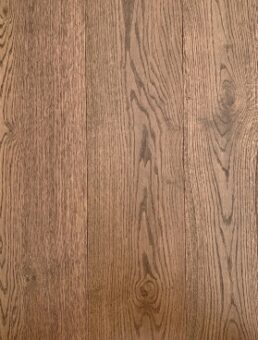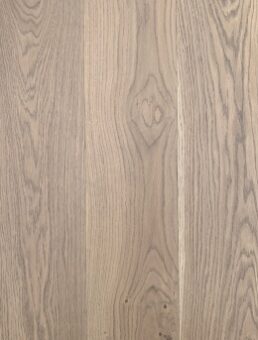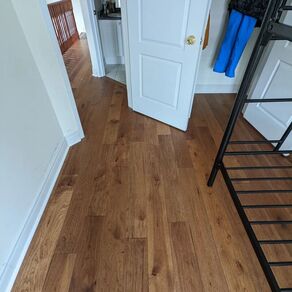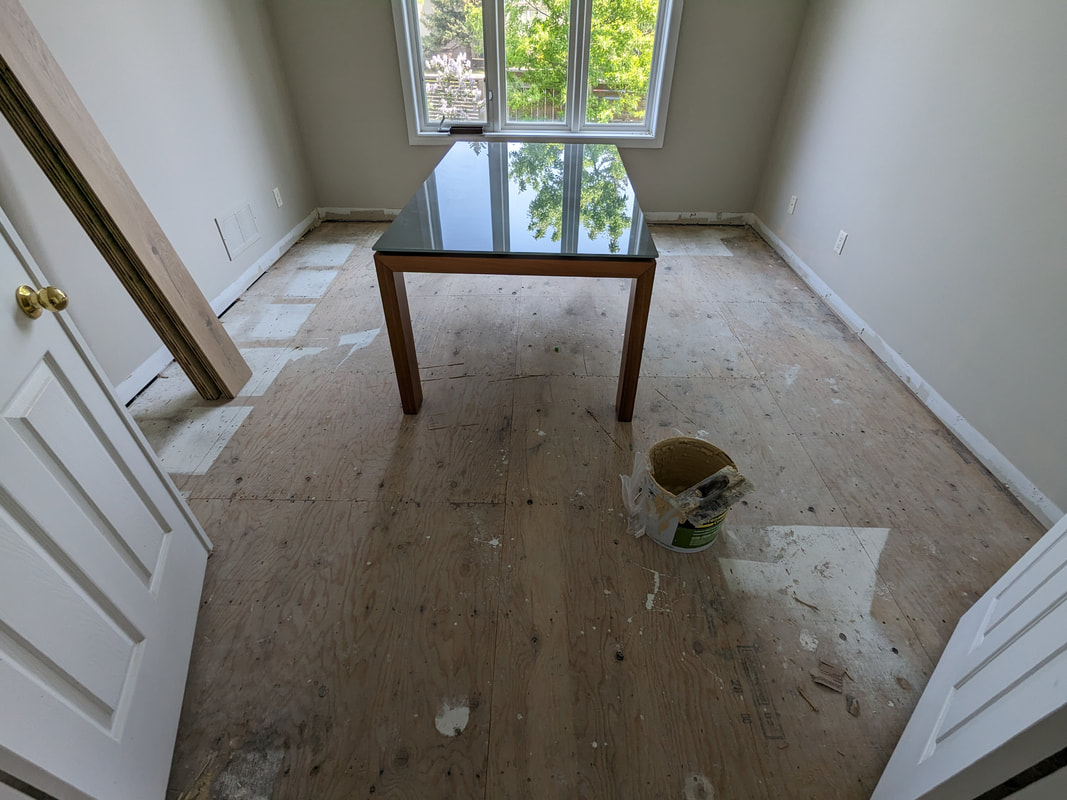|
| There's something undeniably captivating about hardwood floors. Whether it's the rich, natural tones or the intricate grain patterns, hardwood flooring has a way of making a room feel both luxurious and inviting. Here are some reasons why homeowners often gravitate towards this classic choice:
|
Common Disadvantages of Hardwood Flooring and How to Overcome Them
The Issue: Hardwood floors are prone to scratches and dents, especially in high-traffic areas or homes with pets.
The Solution: Opt for hardwoods with a high Janka hardness rating like Hickory or Maple. Additionally, you can apply a durable finish for added protection. Regularly sweeping and using furniture pads can also minimize damage.
2. Sensitive to Moisture
The Issue: Hardwood floors can warp or swell when exposed to moisture, making them less suitable for bathrooms or basements.
The Solution: Consider engineered hardwood flooring, which offers better moisture resistance. Also, maintaining a stable indoor humidity level can prevent warping.
3. High Cost
The Issue: Quality hardwood flooring can be expensive, both in terms of material and installation.
The Solution: Look for promotions or discounts from reputable suppliers. Alternatively, you can opt for less expensive types of hardwood like Oak or Ash without compromising too much on quality.
4. Fading Over Time
The Issue: Prolonged exposure to sunlight can cause hardwood floors to fade over time.
The Solution: Use window treatments like blinds or curtains to limit sun exposure. You can also refinish the floors every few years to restore their original luster.
5. Maintenance
The Issue: Hardwood floors require regular maintenance like sweeping, mopping, and occasional refinishing.
The Solution: Incorporate a low-maintenance finish and establish a regular cleaning routine. For deeper cleans, consider professional hardwood flooring sanding and refinishing.
6. Limited Style Options
The Issue: Unlike tiles or carpets, hardwood floors offer limited patterns and designs.
The Solution: Hardwood floors can be customized with inlays, mixed plank sizes, or different installation patterns like herringbone. For more design inspiration, check out our portfolio.
| While hardwood flooring comes with its own set of challenges, the benefits far outweigh the disadvantages. With the right knowledge and a little effort, you can easily overcome these drawbacks to enjoy the timeless beauty and durability that only hardwood floors can offer. Ready to make an informed decision about your flooring? Contact us at Parqueteam Hardwood Flooring for a consultation. Our experts can guide you through the selection process and help you find the perfect flooring solution for your home. |
Frequently Asked Questions About Hardwood Flooring Disadvantages
- Is hardwood flooring worth the investment?
- Absolutely, especially when you consider its durability and the value it adds to your home. Check out our blog post on which hardwood is best for flooring in Toronto for more insights.
- How do I maintain my hardwood floors?
- Regular sweeping and occasional mopping with a damp cloth are generally sufficient. For more detailed information, read our comprehensive guide on hardwood flooring maintenance.
- What are the alternatives to hardwood flooring?
- Laminate and luxury vinyl plank flooring are popular alternatives. Learn the pros and cons in our blog post comparing hardwood and laminate flooring.
- Can hardwood floors be installed in basements or bathrooms?
- While not ideal due to moisture concerns, engineered hardwood can be a viable option for such areas. Read our post on engineered vs. solid hardwood for more details.
- How much does it cost to install hardwood floors?
- Costs can vary based on the type of wood, installation method, and additional services like removal of old flooring. For a detailed breakdown, visit our hardwood flooring installation page.
Glue Down Engineered Hardwood Flooring: Is It Any Good?
 Close-up of engineered hardwood planks.
Close-up of engineered hardwood planks. What is Engineered Hardwood Flooring?
Glue Down Method for Engineered Hardwood Flooring
| The glue down method is one of the most common installation methods for engineered hardwood flooring. As the name suggests, this method involves using a special adhesive to stick the flooring directly to the subfloor. This method is particularly suitable for concrete subfloors and can also be used on wooden subfloors. One of the main advantages of the glue down method is its stability. Because the flooring is adhered directly to the subfloor, there is less chance of movement and squeaking. This method also allows for thinner profile flooring, which can be beneficial in situations where door clearance or ceiling height is a concern. However, the glue down method can be more time-consuming and requires more skill than other installation methods. It's also important to note that once the flooring is glued down, it can be difficult to remove or replace. Learn more about our hardwood flooring installation services. |
Glue Down vs. Nail Down: Which is Better?
On the other hand, the nail down method involves attaching the flooring to the subfloor using nails or staples. This method is typically used for solid hardwood flooring, but it can also be used for engineered hardwood.
So, which method is better? The answer depends on your specific needs and circumstances. The glue down method provides a more stable floor, but it is more labor-intensive and permanent. The nail down method, on the other hand, is quicker and easier, but it may not provide the same level of stability. You can learn more about the different installation methods on our blog.
Can Engineered Hardwood Flooring be Glued to Plywood?
However, it's important to note that the plywood must be properly prepared before the flooring is installed. This includes ensuring that the plywood is clean, dry, and level. Any irregularities in the plywood can cause problems with the installation and performance of the flooring.
Is Glue Down Installation Better than Floating Installation for Engineered Wood Floors?
| The answer to this question depends on your specific needs and circumstances. The glue down method provides a solid, stable floor that feels more like a solid hardwood floor. However, it is more labor-intensive and permanent than the floating method. On the other hand, the floating method, where the flooring planks are attached to each other but not to the subfloor, is quicker and easier to install. It also allows for the installation of a moisture barrier and underlayment for added insulation and noise reduction. However, floating floors may not feel as solid underfoot as glue down floors. You can learn more about the different types of hardwood flooring and their installation methods on our blog. |
Underlayment for Glue Down Engineered Hardwood Flooring
How Long Before You Can Put Furniture on New Glued Down Engineered Hardwood Floors?
Glue Down Engineered Hardwood Flooring: Maintenance and Longevity
Engineered hardwood flooring is known for its durability and long lifespan, but like any flooring, it requires proper care and maintenance to keep it looking its best.
Maintaining your engineered hardwood flooring is relatively straightforward. Regular sweeping or vacuuming can help remove dust and debris that might scratch the surface. For deeper cleaning, use a damp mop and a cleaner specifically designed for hardwood floors. Avoid using excessive water, as it can seep into the cracks and cause damage.
One of the advantages of engineered hardwood flooring is that it can be refinished if it becomes scratched or worn. However, the number of times it can be refinished depends on the thickness of the top veneer. Some high-quality engineered floors can be refinished multiple times, while others may only be able to be refinished once or twice.
In terms of longevity, engineered hardwood flooring can last for decades with proper care. The exact lifespan will depend on factors such as the quality of the flooring, the amount of foot traffic it receives, and how well it is maintained.
To ensure the longevity of your flooring, consider hiring professional hardwood flooring installers for the installation process. Professionals have the knowledge and experience to install the flooring correctly, which can help prevent issues down the line.
In conclusion, glue down engineered hardwood flooring is a versatile and durable choice for your home. It offers the beauty of real wood with the added stability of engineered construction. Whether you're renovating your current home or building a new one, consider engineered hardwood flooring for a stylish and long-lasting flooring solution.
For more information on engineered hardwood flooring and other types of flooring, check out our blog or contact us at Parqueteam Hardwood Flooring. We're here to help you make the best choice for your home.
Please note that this article is intended to provide general information. For specific advice related to your situation, please consult with a professional.
FAQ
- What is glue down engineered hardwood flooring?
Glue down engineered hardwood flooring is a type of flooring installation method where adhesive is used to bond the flooring directly to the subfloor. This method is commonly used for engineered hardwood flooring, which is made up of multiple layers of wood with a hardwood veneer on top. - Should you glue down engineered hardwood flooring?
Yes, gluing down engineered hardwood flooring is a common and effective installation method. It provides a solid, stable floor that feels more like a solid hardwood floor. - Can engineered flooring be glued down?
Yes, engineered hardwood flooring can be glued down. This method works well with engineered hardwood flooring because it provides a smooth, stable surface for the flooring to adhere to. - Is it better to glue or nail an engineered wood floor?
The answer depends on your specific needs and circumstances. The glue down method provides a more stable floor, but it is more labor-intensive and permanent. The nail down method, on the other hand, is quicker and easier, but it may not provide the same level of stability. - Do you need underlayment for glue down engineered hardwood?
Typically, an underlayment is not required when using the glue down method for engineered hardwood. However, it's always best to follow the manufacturer's instructions. - Is floating better than glue down engineered wood?
The answer to this question depends on your specific needs and circumstances. The floating method, where the flooring planks are attached to each other but not to the subfloor, is quicker and easier to install. However, floating floors may not feel as solid underfoot as glue down floors. - How long before you can put furniture on new glued down engineered hardwood floors?
After installing glue down engineered hardwood flooring, it's recommended to wait at least 24 hours before placing furniture on the new floors. This allows the adhesive to fully cure and ensures a strong bond between the flooring and the subfloor. - Can you glue engineered hardwood flooring to plywood?
Yes, engineered hardwood flooring can be glued to plywood. In fact, plywood is one of the most common types of subfloor that engineered hardwood flooring is installed on. - How long does engineered hardwood flooring last?
With proper care and maintenance, engineered hardwood flooring can last for decades. The exact lifespan will depend on factors such as the quality of the flooring, the amount of foot traffic it receives, and how well it is maintained.
Choosing the Best Hardwood Flooring for Your Toronto Home: Engineered vs. Solid

| Hardwood Flooring in Toronto: Engineered vs. Solid Hardwood flooring comes in two main types: solid and engineered. Solid hardwood flooring is made from a single piece of wood, while engineered hardwood flooring consists of a top layer of real wood adhered to multiple layers of plywood or high-density fibreboard. In the Toronto climate, where humidity levels can vary greatly between seasons, engineered hardwood flooring often has the edge. Its multi-layered construction makes it less susceptible to shrinking and expanding due to changes in humidity and temperature. This makes engineered hardwood flooring a robust and durable choice for Toronto homes. |
| Hardwood Flooring Installation: Choosing the Right Species The species of wood you choose for your hardwood flooring installation also matters. Common choices in Canada include Oak, Maple, and Hickory.
|

Engineered hardwood flooring offers the beauty of solid wood but with increased stability. This makes it particularly suitable for the Canadian climate. The plywood base layers handle humidity changes better than solid wood, reducing the risk of warping or cupping.
Plus, engineered hardwood flooring can be refinished, just like solid hardwood. This means that, even after years of use, your floors can look as good as new with a bit of maintenance.
When it comes to hardwood flooring in Toronto, engineered hardwood flooring stands out as a top choice. Its durability, resistance to climate-induced damage, and the wide variety of available species make it an excellent option for any home.
Remember, the best hardwood flooring is not only about the type of wood or the construction method. It's about choosing a floor that matches your style, meets your family's needs, and stands up to Toronto's unique climate. With the right choice, you can enjoy the beauty and warmth of hardwood floors for many years to come.
 Engineered hardwood flooring
Engineered hardwood flooring Also, engineered hardwood floors can be installed over concrete, and in apartments and basements without having a subfloor installed before.
The introduction of engineered hardwood floor solved a lot of issues that homeowners faced with hardwood floors such as the humidity issue, high installation costs when trying to install solid floor over concrete or in apartment, and more importantly, it adds more flexibility to your budget, making sure you can afford and enjoy new wooden floors at your place!

Regardless of your residence type (condo, apartment or a house) you cannot go wrong with the solid hardwood flooring installation. Whether you own a business venue or private residence, hardwood flooring installation will immediately increase an overall value of the entire property. In addition, there is eco-friendly hardwood flooring materials available. It is a healthy choice for both pet owners and parents. If you are looking for a long term investment into your property, hardwood floors probably would be a best option. It increases the value of your residence instantly and costs are paid off quickly.
Almost every client is considering to put a grey coloured floor. It became one of the most popular colours, and not only with floors, but walls and stair cases as well. Some prefer more darker tone, others would prefer the lighter one, as long as there is grey.
Below attached few grey toned flooring pictures for some ideas for your next flooring project! Purchasing hardwood floors in Toronto, and choosing its colours, is one fun process!
 Engineered Hardwood Floors - Environmentally Friendly
Engineered Hardwood Floors - Environmentally Friendly One of the main concerns people have had with engineered hardwood floors is the claim that they are not real. Let’s get this claim straight: It is simply not true. The top layer of the engineered hardwood floors is made of real wood, (in some cases bottom too, for more expensive types), and the bottom (or middle) made of different layers of plywood.
This particular structure eliminates the full solid wood structure, which tends to waste more wood.
Also, that same-engineered hardwood floors has enough thick wood thread on top to be able to refinish it in the future.
So, next time you go to shop for hardwood floors, and worries about the environment, then do not hesitate to go for the engineered hardwood floors. It is durable, in some cases cheaper, looks exactly the same like solid hardwood, but better for the environment.
 Clean Hardwood Floors
Clean Hardwood Floors * Any substance spilled on the hardwood floors needs to be wiped immediately in order to prevent future buckling and dryness to the spot where the spill occurred. Remember, water and hardwood floors do not work together well!
* The floors need to be moped or vacuumed at least ones a week or more frequent. Soft vacuum head (or soft brash attached to a vacuum head) is preferable. As for mopping, a special mop can be found in various hardware or hardwood flooring stores in Toronto. AVOID USING WATER! There are many cleaning solutions for hardwood floors!
* Furniture legs should be protected with the soft pads in order to prevent any scratches or severe damage due to the furniture weight or shifting.
* It is a good idea to use rugs in a high traffic area, around the kitchen sink or near the front door of your residence.
* If you decided to move your furniture, make sure you are not dragging it again the floor. The top layer could be scratch. (Lift the furniture or place soft material under the furniture in order to prevent any floor damage)
By following these simple steps, your hardwood floor should look brand new all the time and last for the decades it should last! Enjoy!
 Engineered Hardwood Flooring
Engineered Hardwood Flooring Since top parts of the engineered floors are made from solid wood, it is almost impossible to distinguish engineered floors from more expensive types of flooring such as solid hardwood flooring. In addition, during the installation process, piles are placed on each other, but in the opposite direction, which gives such great stability.
Over all, if the homeowner does not have any plywood base subfloor (concrete for example), and still wants hardwood floor instead of laminate, engineered hardwood flooring is the way to go. (It is also great for plywood subfloor)
Parqueteam Hardwood Flooring
Hardwood Flooring Toronto and The Greater Toronto Area.
Archives
December 2023
November 2023
October 2023
September 2023
August 2023
June 2023
May 2023
April 2023
July 2018
February 2018
January 2018
December 2017
March 2017
February 2017
January 2017
November 2016
October 2016
May 2016
March 2016
February 2016
January 2016
December 2015
November 2015
October 2015
September 2015
August 2015
July 2015
June 2015
May 2015
April 2015
March 2015
February 2015
January 2015
December 2014
June 2014
May 2014
April 2014
March 2014
Categories
All
Affordable Flooring
Art Flooring
Canada
Canadian
Clean Hardwood Floors
Cleaning Hardwood Floors
Commercial Hardwood Flooring
Condos
Construction
Construction Materials
Consturction
Contractors
Cost And Budgeting
Dark Hardwood Flooring
Design
DIY
Durable Hardwood Floors
Engineered Hardwood
Engineered Hardwood Flooring
Engineered Hardwood Flooring Toronto
Engineered Hardwood Floors
Engineered Wood Floors
European Hardwood Flooring
Floating Hardwood Flooring
Flooring
Flooring Baseboards
Flooring Baseboards Installation
Flooring Benefits
Flooring Comparison
Flooring FAQs
Flooring Guide
Flooring Innovation
Flooring Installation
Flooring Maintenance
Flooring Options
Flooring Refinishing
Flooring Solutions
Flooring Styles And Patterns
Flooring Tips
Flooring Tips And Guides
Flooring Trends
Floors
Glue Down Hardwood Floors
Hardwood
Hardwood Floor
Hardwood Flooring
Hardwood Flooring Contractor
Hardwood Flooring Contractors
Hardwood Flooring Contractors In Toronto
Hardwood Flooring Contractors Toronto
Hardwood Flooring Finishes
Hardwood Flooring Installation
Hardwood Flooring Installation Cost
Hardwood Flooring Installation In Markham
Hardwood Flooring Installation In Toronto
Hardwood Flooring Installation Toronto
Hardwood Flooring Installers In Toronto
Hardwood Flooring In Toronto
Hardwood Flooring Markham
Hardwood Flooring Refinishing
Hardwood Flooring Repairs
Hardwood Flooring Sanding And Refinishing
Hardwood Flooring Toronto
Hardwood Flooring Trends
Hardwood Floors
Hardwood Floors Toronto
Hardwood Stairs
Hickory Flooring
Home Decor
Home Decor Tips
Home Design
Home Improvement
Home Imrovement
Home Investment
Home Renovation
Home Renovations
Homes
Home Solutions
House
Installation
Interior Design
Interiors
Kitchen Remodeling
Laminate
Laminate Flooring
Laminate Flooring Installation
Laminate Flooring Installation Toronto
Laminate Flooring Installers
Laminate Flooring Toronto
Laminate Floors
Maple Flooring
Modern Home Improvement
Oak Flooring
Parqueteam
Parqueteam Hardwood Flooring
Real Estate
Real Estate Value Enhancement
Refinishing
Solid Vs Engineered Flooring
Solid Wood Flooring
Staining Hardwood Floors
Sustainable Flooring
Tips
Toronto
Toronto Climate
Toronto Flooring
Toronto Flooring Services
Toronto Hardwood Flooring
Toronto Home Improvement
Toronto Homeowners
Toronto Homeowners Guide
Toronto Home Renovation
Toronto Home Style
Toronto Living
Toronto Real Estate
Wood
Wooden Floors
Wood Flooring
Wood Flooring Installation
Wood Flooring Installation In Toronto
Wood Flooring Toronto
Wood Floors
Wood Stairs Installation Toronto
Wood Stairs Toronto






























 RSS Feed
RSS Feed

